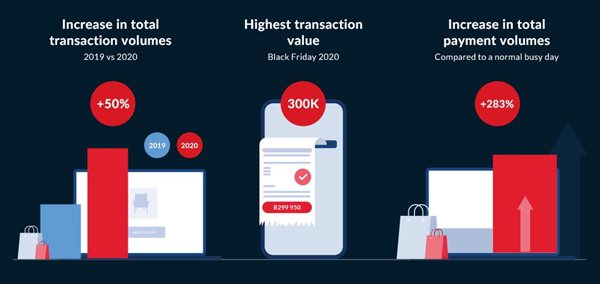The number of new shoppers introduced to e-commerce over lockdown boosted Black Friday weekend total online transaction volumes by 50%, compared to 2019. This is according to data released by online payment gateway PayFast.

Getty
The company processed a 283% increase in total payment volumes on Black Friday alone compared to a normal busy day such as payday.
“This year’s Black Friday spend surpassed the volumes we’ve seen in previous years. The rapid adoption of e-commerce over the course of 2020 has meant that we’ve seen more people shopping online, especially amid fears of a Covid-19 resurgence,” says Jonathan Smit, managing director and founder of PayFast.
The highest transaction for the day was R299,950 and online shoppers spent more per basket at R1,243, compared to the 2020 average basket value of R803. “Alongside big-ticket items like TVs and gaming consoles, more purchases were made online for items that are traditionally brick-and-mortar retail store focused, like toiletries, cosmetics and essentials,” says Smit.

Credit: PayFast
True to buyer trends seen during lockdown, 66% of purchases were made using a mobile device. “Smartphone usage means you can shop literally from anywhere, any time. We’re seeing merchants and payment methods better cater towards the demand for mobile too,” says Smit.
This year, 66% of transactions were made using cards, but alternative online payment options are on the rise. “Instant EFT, QR codes and mobile wallets are becoming more popular as consumers become more comfortable shopping online,” explains Smit.
Over the past six months retailers have invested in their online platforms to offer better user experiences for first-time shoppers. “This Black Friday offered a more considered and improved customer experience across the board. Lockdown was a good test for many e-commerce businesses, with lessons carried into this peak period,” Smit says.
Muted in-store spend
Meanwhile, Nedbank reported more than 60% growth in digital Black Friday transactions and a decline in traditional physical instore activity. Mpho Sadiki, executive: card and payments acceptance at Nedbank, says that this data reflects the rapid shift from physical to digital consumption.
“Consumer spend by Nedbank clients across digital shopping channels has shown significantly higher growth levels than those of traditional (brick and mortar) channels, which not only points to changing consumer behaviour in general due to the pandemic, but also that more South Africans used digital channels specifically to do their Black Friday shopping this year.”
While Nedbank’s payment data points to the possibility that the economic fallout of the pandemic may have resulted in slightly muted overall Black Friday retail activity (down 5% year-on-year), this was largely due to lower physical sales volumes and turnover figures. In contrast, total digital turnover (in terms of Nedbank processed payments) across all enterprises increased by 52% year-on-year.
SME performance
While large enterprise digital sales contributed 36% to this figure, they actually saw a drop of 9% in volume, according to Nedbank data. SMEs, on the other hand, enjoyed a 12% rise in volumes year-on-ear, and digital turnover for this vital segment was up a staggering 173%.
“The outstanding performance by SMEs over Black November is especially significant because it demonstrates the effect that this shift towards digitised consumption can, and will, have in terms of levelling the retail playing field and creating an environment in which all merchants are able to compete fairly for share of market – which is obviously of great benefit for consumers as well," Sadiki points out.
Sadiki adds that Nedbank's data from the past few weeks of retail activity reveals that "what we have seen over November is not just a fear-driven rise in ‘remote’ shopping. While Covid-19 and Black Friday may have been catalysts, the digital trend was already firmly in place, and will continue to build as digital consumption becomes even more entrenched as a day-to-day reality.”





































